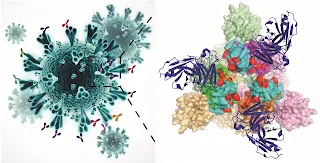A new analysis by a large team of geneticists and anthropologists from several North American Universities, of remains, including DNA, recovered from a site in Malawi, Tanzania and Zambia, Africa, has revealed new details of the movements and interactions of Early Africans. The individuals whose remains were analysed lived between 18,000 and 5,000. This is more than twice the age of previously recovered human DNA from sub-Saharan Africa.
The study also reanalysed published data from 28 individuals buried at sites across the continent, generating new and improved data for 15 of them. The results are published, open access, in the journal Nature.
The Rice University press release accompanying this publication explains:
The result was an unprecedented dataset of DNA from ancient African foragers — people who hunted, gathered or fished. Their genetic legacy is difficult to reconstruct from present-day people because of the many population movements and mixtures that have occurred in the last few thousand years.The main conclusions from the study is that there were two highly-diverged populations before about 80-20 thousand years ago: one in East Africa, one in Southern Africa and a ubiquitous population ancestral population that is represented today by the Central African rainforest hunter-gatherers. The team's findings are published, open access, in Nature:
We've never been able to directly explore these proposed demographic shifts, until now," she said. “It has been difficult to reconstruct events in our deeper past using the DNA of people living today, and artifacts like stone tools and beads can’t tell us the whole story. Ancient DNA provides direct insight into the people themselves, which was the missing part of the puzzle.Thanks to this data, the researchers were able to outline major demographic shifts that took place between about 80,000 and 20,000 years ago. As far back as about 50,000 years ago, people from different regions of the continent moved and settled in other areas and developed alliances and networks over longer distances to trade, share information and even find reproductive partners. This social network helped them survive and thrive, the researchers wrote.
Maybe it was because by that point, previously established social networks allowed for the flow of information and technologies without people having to move.
Assistant professor Elizabeth A. Sawchuk, co-author
Department of Anthropology
University of Alberta, Edmonton, Alberta, Canada And Department of Anthropology
Stony Brook University
Stony Brook, NY, USA
Our genetic study confirms an archaeological pattern of more local behavior in eastern Africa over time. At first people found reproductive partners from wide geographic and cultural pools. Later, they prioritized partners who lived closer, and who were potentially more culturally similar.Elizabeth Sawchuk, an author of the study who is a Banting Postdoctoral Fellow at the University of Alberta and research assistant professor at Stony Brook University, said a dramatic cultural change took place during this timeframe, as beads, pigments and other symbolic art became common across Africa. Researchers long assumed that major changes in the archaeological record about 50,000 years ago reflected a shift in social networks and maybe even changes in population size. However, such hypotheses have remained difficult to test.
Assistant professor Jessica Thompson, co-author
Department of Anthropology and Peabody Museum of Natural History
Yale University, New Haven, CT, USA
And Institute of Human Origins
School of Human Evolution and Social Change
Arizona State University, Tempe, AZ, USA.
Humans began relying on each other in new ways, and this creativity and innovation might be what allowed people to thrive.Mary Prendergast, an author of the paper and associate professor of anthropology at Rice University, said there are arguments that the development and expansion of long-distance trade networks around this time helped humans weather the last Ice Age.
There are around 30 times more published ancient DNA sequences from Europe than from Africa. Given that Africa harbors the greatest human genetic diversity on the planet, we have much more to learn.
Assistant professor Mary E. Prendergast, co-author
Department of Genetics
Harvard Medical School, Boston, MA, USA
And Department of Anthropology
Rice University, Houston, TX, USA
[…]
By associating archaeological artifacts with ancient DNA, the researchers have created a remarkable framework for exploring the prehistory of humans in Africa," said Archaeology and Archaeometry program director John Yellen of the U.S. National Science Foundation, one of the funders behind this project. "This insight is charting a new way forward to understanding humanity and our complex shared history.Prendergast said the study provides a better understanding of how people moved and mingled in this part of Africa. Previously, the earliest African DNA came from what is now Morocco — but the individuals in this study lived as far from there as Bangladesh is from Norway, she noted.
John Yellen
Archaeology and Archaeometry program director
U.S. National Science Foundation
[…]
This work shows why it’s so important to invest in the stewardship of human remains and archaeological artifacts in African museums.The research team included scholars from Canada, Kenya, Malawi, Tanzania, the United States, Zambia and many other countries. Critical contributions to the study came from curators and co-authors at African museums who are responsible for protecting and preserving the remains.
Potiphar Kaliba, co-author
Research Director
Malawi Department of Museums and Monuments
Lilongwe, Malawi
Potiphar Kaliba, director of research at the Malawi Department of Museums and Monuments and an author of the study, noted that some of the skeletons sampled for the study were excavated a half-century ago, yet their DNA is preserved despite hot and humid climates in the tropics.

a, Locations of individuals analysed in this study. The shapes and
colours of the symbols correspond to the PCA in b. 1, Shum Laka; 2,
Mota Cave; 3, Kakapel RS (Rockshelter); 4, Nyarindi RS; 5, Jawuoyo RS; 6,
White Rock Point; 7, Panga ya Saidi; 8, Makangale Cave; 9, Kuumbi Cave; 10,
Gishimangeda Cave; 11, Kisese II RS; 12, Mlambalasi RS; 13, Fingira; 14,
Hora 1; 15, Chencherere II; 16, Kalemba RS; 17, Ballito Bay; 18, Faraoskop
RS; 19, St Helena. b, PCA results. Axes were computed using
present-day groups from eastern (Dinka pastoralists), southern (Juǀ'hoansi
foragers) and central Africa (Mbuti foragers). Small circles represent
present-day individuals; other symbols represent ancient individuals (larger
points corresponding to earlier individuals and black outlines to newly
reported individuals). The lowest-coverage individual (from Mlambalasi),
shown with an asterisk, has the most uncertain position. The base map in
a is from Natural Earth (https://www.naturalearthdata.com). E., east.
AbstractThe picture then is of a species that spread far and wide within Africa, as well as out of Africa into Eurasia and eventually beyond, to form relatively isolated populations that diverged enough to form genetically distinct populations but within which interbreeding was frequent enough to prevent divergence into sub-species or species, to produce a genetically diverse single pan-African human species. There is probably a great deal more to learn in terms of the interchange and spread of new technologies and cultures as well as about the patterns of migration as the climate changed.
Multiple lines of genetic and archaeological evidence suggest that there were major demographic changes in the terminal Late Pleistocene epoch and early Holocene epoch of sub-Saharan Africa1,2,3,4. Inferences about this period are challenging to make because demographic shifts in the past 5,000 years have obscured the structures of more ancient populations3,5. Here we present genome-wide ancient DNA data for six individuals from eastern and south-central Africa spanning the past approximately 18,000 years (doubling the time depth of sub-Saharan African ancient DNA), increase the data quality for 15 previously published ancient individuals and analyse these alongside data from 13 other published ancient individuals. The ancestry of the individuals in our study area can be modelled as a geographically structured mixture of three highly divergent source populations, probably reflecting Pleistocene interactions around 80–20 thousand years ago, including deeply diverged eastern and southern African lineages, plus a previously unappreciated ubiquitous distribution of ancestry that occurs in highest proportion today in central African rainforest hunter-gatherers. Once established, this structure remained highly stable, with limited long-range gene flow. These results provide a new line of genetic evidence in support of hypotheses that have emerged from archaeological analyses but remain contested, suggesting increasing regionalization at the end of the Pleistocene epoch.
Lipson, Mark; Sawchuk, Elizabeth A.; Thompson, Jessica C.; Oppenheimer, Jonas; Tryon, Christian A.; Ranhorn, Kathryn L.; de Luna,Kathryn M.; Sirak, Kendra A.; Olalde, Iñigo; Ambrose, Stanley H.; Arthur, John W.; Arthur, Kathryn J. W.; Ayodo, George; Bertacchi, Alex; Cerezo-Román, Jessica I.; Culleton, Brendan J.; Curtis, Matthew C.; Davis, Jacob; Gidna, Agness O.; Hanson, Annalys; Kaliba, Potiphar; Katongo, Maggie; Kwekason, Amandus; Laird, Myra F.; Lewis, Jason; Mabulla, Audax Z. P.; Mapemba, Fredrick; Morris, Alan; Mudenda, George; Mwafulirwa, Raphael; Mwangomba, Daudi; Ndiema, Emmanuel; Ogola, Christine; Schilt, Flora; Willoughby, Pamela R.; Wright, David K.; Zipkin, Andrew; Pinhasi, Ron; Kennett, Douglas J.; Manthi, Fredrick Kyalo; Rohland, Nadin; Patterson, Nick; Reich, David; Prendergast, Mary E.
Ancient DNA and deep population structure in sub-Saharan African foragers
Nature (2022). DOI: 10.1038/s41586-022-04430-9
Copyright: © 2022 The authors. Published by Springer Nature Ltd.
Open access
Reprinted under a Creative Commons Attribution 4.0 International license (CC BY 4.0)






































